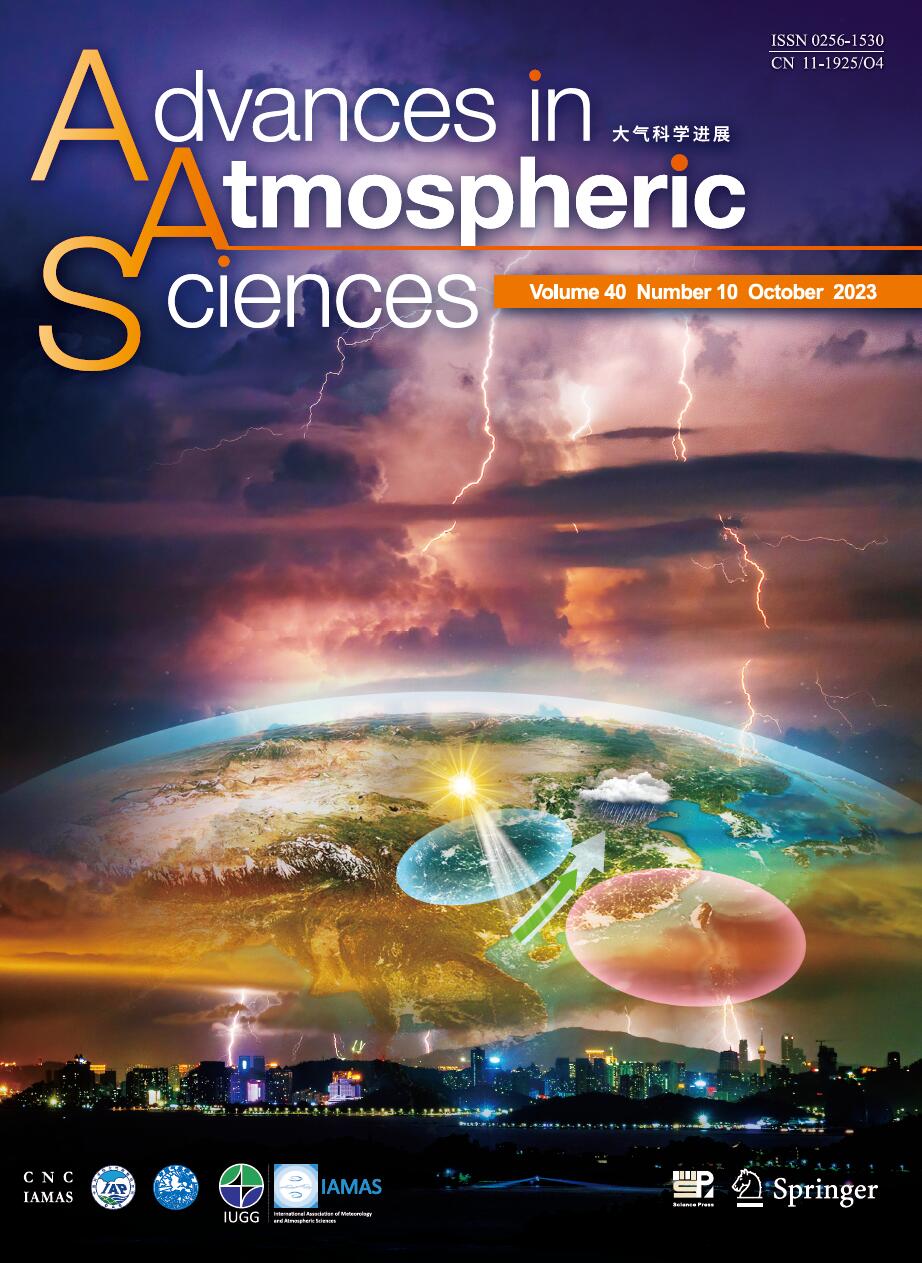| [1] |
Wu Rongsheng, Fang Juan,
2001: Mechanism of Balanced Flow and Frontogenesis, ADVANCES IN ATMOSPHERIC SCIENCES, 18, 323-334.
doi: 10.1007/BF02919313
|
| [2] |
Majid M. Farahani, Wu Rongsheng,
1998: A Numerical Study of Geostrophic Adjustment and Frontogenesis, ADVANCES IN ATMOSPHERIC SCIENCES, 15, 179-192.
doi: 10.1007/s00376-998-0038-0
|
| [3] |
YANG Shuai, GAO Shouting, LU Chungu,
2014: A Generalized Frontogenesis Function and Its Application, ADVANCES IN ATMOSPHERIC SCIENCES, 31, 1065-1078.
doi: 10.1007/s00376-014-3228-y
|
| [4] |
Fang Juan, Wu Rongsheng,
2002: Energetics of Geostrophic Adjustment in Rotating Flow, ADVANCES IN ATMOSPHERIC SCIENCES, 19, 845-854.
doi: 10.1007/s00376-002-0049-1
|
| [5] |
ZHOU Lingli, DU Huiliang, ZHAI Guoqing, WANG Donghai,
2013: Numerical Simulation of the Sudden Rainstorm Associated with the Remnants of Typhoon Meranti (2010), ADVANCES IN ATMOSPHERIC SCIENCES, 30, 1353-1372.
doi: 10.1007/s00376-012-2127-3
|
| [6] |
Guoping SHI, Xinfa QIU, Yan ZENG,
2018: New Method for Estimating Daily Global Solar Radiation over Sloped Topography in China, ADVANCES IN ATMOSPHERIC SCIENCES, 35, 285-295.
doi: 10.1007/s00376-017-6243-y
|
| [7] |
PENG Jiayi, FANG Juan, WU Rongsheng,
2004: Interaction of Mesoscale Convection and Frontogenesis, ADVANCES IN ATMOSPHERIC SCIENCES, 21, 814-823.
doi: 10.1007/BF02916377
|
| [8] |
Fang Juan, Wu Rongsheng,
1998: Frontogenesis, Evolution and the Time Scale of Front Formation, ADVANCES IN ATMOSPHERIC SCIENCES, 15, 233-246.
doi: 10.1007/s00376-998-0042-4
|
| [9] |
Yang Hongwei, Wang Bin, Ji Zhongzhen,
2002: Application of the Artificial Compression Method to the Simulation of Two-Dimensional Frontogenesis, ADVANCES IN ATMOSPHERIC SCIENCES, 19, 863-869.
doi: 10.1007/s00376-002-0051-7
|
| [10] |
Wang Yunfeng, Wu Rongsheng, Pan Yinong,
2000: Evolution and Frontogenesis of an Imbalanced Flow —the Influence of Vapor Distribution and Orographic Forcing, ADVANCES IN ATMOSPHERIC SCIENCES, 17, 256-274.
doi: 10.1007/s00376-000-0008-7
|
| [11] |
Guojing LI, Dongxiao WANG, Changming DONG, Jiayi PAN, Yeqiang SHU, Zhenqiu ZHANG,
2024: Frontogenesis and Frontolysis of a Cold Filament Driven by the Cross-Filament Wind and Wave Fields Simulated by a Large Eddy Simulation, ADVANCES IN ATMOSPHERIC SCIENCES, 41, 509-528.
doi: 10.1007/s00376-023-3037-2
|
| [12] |
YANG Shuai, GAO Shouting, Chungu LU,
2015: Investigation of the Mei-yu Front Using a New Deformation Frontogenesis Function, ADVANCES IN ATMOSPHERIC SCIENCES, 32, 635-647.
doi: 10.1007/s00376-014-4147-7
|
| [13] |
Zhang Fuqing, Steven E. Koch, Christopher A. Davis,
2000: A survey of Unbalanced Flow Diagnostics and Their Application, ADVANCES IN ATMOSPHERIC SCIENCES, 17, 165-183.
doi: 10.1007/s00376-000-0001-1
|
| [14] |
Zhao Ming,
1991: The Effect of Topography on Quasi-Geostrophic Frontogenesis, ADVANCES IN ATMOSPHERIC SCIENCES, 8, 23-40.
doi: 10.1007/BF02657362
|
| [15] |
Qingchang QIN, Xueshun SHEN, Chungang CHEN, Feng XIAO, Yongjiu DAI, Xingliang LI,
2019: A 3D Nonhydrostatic Compressible Atmospheric Dynamic Core by Multi-moment Constrained Finite Volume Method, ADVANCES IN ATMOSPHERIC SCIENCES, 36, 1129-1142.
doi: 10.1007/s00376-019-9002-4
|
| [16] |
Xinlin YANG, Jianhua SUN,
2018: Organizational Modes of Severe Wind-producing Convective Systems over North China, ADVANCES IN ATMOSPHERIC SCIENCES, 35, 540-549.
doi: 10.1007/s00376-017-7114-2
|
| [17] |
Shaukat ALI, DAN Li, FU Congbin, YANG Yang,
2015: Performance of Convective Parameterization Schemes in Asia Using RegCM: Simulations in Three Typical Regions for the Period 1998-2002, ADVANCES IN ATMOSPHERIC SCIENCES, 32, 715-730.
doi: 10.1007/s00376-014-4158-4
|
| [18] |
Mengyu DENG, Riyu LU, Chaofan LI,
2022: Contrasts between the Interannual Variations of Extreme Rainfall over Western and Eastern Sichuan in Mid-summer, ADVANCES IN ATMOSPHERIC SCIENCES, 39, 999-1011.
doi: 10.1007/s00376-021-1219-3
|
| [19] |
LIU Guimei, WANG Hui, SUN Song, HAN Boping,
2003: Numerical Study on the Velocity Structure around Tidal Fronts in the Yellow Sea, ADVANCES IN ATMOSPHERIC SCIENCES, 20, 453-460.
doi: 10.1007/BF02690803
|
| [20] |
Zipeng YUAN, Xiaoyong ZHUGE, Yuan WANG,
2020: The Forced Secondary Circulation of the Mei-yu Front, ADVANCES IN ATMOSPHERIC SCIENCES, 37, 766-780.
doi: 10.1007/s00376-020-9177-8
|















 AAS Website
AAS Website 
 AAS WeChat
AAS WeChat 
 DownLoad:
DownLoad: